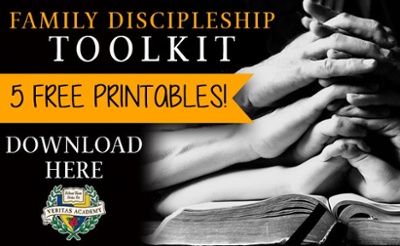“Whoever knows well how to distinguish the Gospel from the Law should give thanks to God and know that he is a real theologian.”
—Martin Luther (LW 26:115.)
Even as adults, we desire simplicity. There is something beautiful and immediately useful in organizing life around simple (not simplistic) concepts and procedures. The same may be said about how we train or children. For example, when our son feeds the cats, he first needs to assess the need (whether food is needed and how much), then he must provide the proper portions, and finally, assess whether all the cats are being nourished. After this, our son follows this same pattern in caring for the chickens and the sheep. In time, this pattern leads to habit, benefitting the whole family.
 As in daily activities and chores, the beauty of simplicity also relates to the theological instruction of our children. On the surface, relating Christian theology to parental instruction might appear daunting. Scripture is vast in scope and sometimes appears quite complex. Nevertheless, our responsibility is to daily instruct our children in God’s Word (Prov. 22:6, Eph. 5:4, 2 Tim 3:14-15). Not surprisingly, we are easily overwhelmed in light of Scripture’s immensity, and our own frailty as parents. Fortunately, there is a time-honored resource for parents seeking theological simplicity—the catechisms.
As in daily activities and chores, the beauty of simplicity also relates to the theological instruction of our children. On the surface, relating Christian theology to parental instruction might appear daunting. Scripture is vast in scope and sometimes appears quite complex. Nevertheless, our responsibility is to daily instruct our children in God’s Word (Prov. 22:6, Eph. 5:4, 2 Tim 3:14-15). Not surprisingly, we are easily overwhelmed in light of Scripture’s immensity, and our own frailty as parents. Fortunately, there is a time-honored resource for parents seeking theological simplicity—the catechisms.
A parent's aid for instructing children in Biblical truth
The word catechism, derived from the Greek, means ‘instruction’ or ‘teaching.’ Ever since the start of the Protestant Reformation, few resources have been more valuable for theological instruction than catechisms. These catechisms varied in length with their question and answer format, but typically included the Apostle’s Creed, the Ten Commandments, and the Lord’s Prayer.
Whether these catechisms derived from Lutheranism (Luther’s Small and Large Catechisms), or from the Swiss Reformed, (Geneva, Heidelberg, etc.), they had a shared organizing framework or principle for instruction. That principle was the distinction between and application of two voices in Scripture—the Law and Gospel. For Luther and other Reformers (Melanchthon, Calvin, Beza, Ursinus, and so on), the Law-Gospel distinction was of vital importance for understanding Scripture and promoting its practical relevance.
The first voice is Law (for example, Deuteronomy 27 and Luke 10). Essentially, the message is: ‘Do this and live, but cursed is everyone who does not continue in all that the Law commands.’ However, the Law is bad news, not because the Law is sinful, but because we are. The Law exposes our sin and that we cannot possibly merit God’s favor. Acceptance with God must be found somewhere else.
This leads to the second voice: Gospel. Here the message is not ‘do’ but rather, ‘it is done.’ And so the Law spotlights Christ at center stage. As Luther states: ‘The Law says, do this, and it is never done; grace says, believe this, and everything is already done.’ This ‘already done’ pertains to the work of the second person of the Godhead, who partook of true humanity. Throughout his earthly ministry, Jesus Christ not only perfectly obeyed the Law, but also bore on the cross the curses of the Law due to our disobedience. For those who trust in Christ alone, Christ’s righteousness is imputed to them, he who is their complete redemption and righteousness.
Guilt - Grace - Gratitude
Unfortunately, the Law-Gospel distinction tends to be lost or blurred when it comes to instructing our children. As a result, our instruction unfortunately tends toward either moralistic platitudes (Law-exclusive) or apathetic license (Gospel-exclusive). One helpful corrective to such consequences is the Heidelberg Catechism (1563). This catechism’s focus on the Law and Gospel follows a three-fold structure, patterned after the book of Romans. The first aspect is Guilt (Q&A 3-11), and pertains to God’s Law in exposing our misery and pointing to Christ. The second aspect is Grace (Q&A 12-85), and pertains to the Gospel of Christ, who is our complete redemption and righteousness. The Third aspect is Gratitude (Q&A 86-129), pertaining to our thankful response reflected in the moral norm for believers found in the Ten Commandments. The Heidelberg therefore moves from Law to Gospel to Law, while keeping Christ in center focus (the Law has several uses, two of which are to expose sin and to serve as a guide for grateful saints). The three-fold order of the Heidelberg Catechism was essential to the practical instruction of young and old alike.

On what (or whom) does our discipline focus?
So how does the Heidelberg Catechism’s pattern assist us in instructing our children today? Perhaps a simple illustration might help. Suppose my son stole a few pretzels from a classmate’s lunchbox, and that later, I am notified of my child’s action. How might I instruct my child?, I have several options. I could look at myself as a failure, and blame my child’s behavior on my imperfections. Or, I could look at myself in too great a light, and thereby discipline my child with a certain disgust, downplaying my own thievery and accentuating my child's. However, in both instances, my instruction is egocentric, I have turned my child’s gaze toward myself as parent—and suddenly, perhaps unknowingly, I have become the new standard and motivation for my child’s behaviors. This is most unfortunate, for it should be painfully obvious that I cannot rescue myself nor my child from our sin and misery.
Still another option is to expose my child’s sin by clearly laying out the 8th commandment: ‘Thou shalt not steal’ (Ex. 20:15). Here at least, God’s Law is the standard in evaluating and exposing my child’s behavior. This much is useful, since an important function of the Law is to reveal our sin and misery (Heidelberg Q&A 3). And so, in breaking the 8th commandment, my child has transgressed the Law’s summary—loving God and neighbor. Yet godly instruction requires more--the Law is designed to lead us, and our children, to the gospel of Christ (Rom. 10, Gal. 3).
A final option is to pattern our instruction after the Heidelberg Catechism, weaving this simple pattern into our instruction: (1) letting the Law expose our sin (Q&A 3-11), (2) focusing on God’s grace in Christ (Q&A 12-85), and (3) a grateful response. It is important to observe that both Romans and the Heidelberg Catechism devote most of their attention to Grace/Gospel. After all, Christ alone is the perfect prophet, priest, and king (Q&A 31), and those who are ingrafted into Christ, through faith, receive all his benefits (Q&A 20). This should encourage us to diligently attend to the Father’s manifold grace of Christ, sealed to us by the Holy Spirit. With this in mind, the reasonable and inevitable response to grace is one of gratitude. A heart enflamed with the gospel of Christ cannot but help produce fruits of thankfulness. Naturally then, both Romans (chapters 12-16) and the Heidelberg Catechism (Q&A 86-129) conclude with a resounding call toward thankfulness. Here the Law (the moral Law contained in the Ten Commandments) becomes for the grateful saint not a stern schoolmaster, but a cheering coach. And so we do not follow the Law in order to be accepted by God, but we follow the Law because we have been accepted by God in Christ.
An example: Applying it to your children's discipline
Guilt
For example, in instructing my child who stole the pretzels, it would be useful to begin by letting the Law serve the function of exposing sin. Since the Law displays our sin and misery, I am encouraged to bring the 8th commandment clearly before my child, exposing their deep need for Christ (as well as mine). But I do not end there, since the Law intends to lead us to Christ. And so next I might share with my child a Gospel narrative that displays Christ who perfectly followed the 8th commandment (for example, Mark 11:1-6). I might also encourage my child to identify another Gospel narrative where Christ not only rejected stealing but always sought his neighbor’s good, their material benefit (Mark 8:1-9).
Grace
From this, I would turn to Grace—Christ’s benefits for us. Specifically, that Christ’s perfect obedience of the 8th commandment is his righteousness imputed to us by grace alone, through faith. The Father’s well-beloved Son is our complete redemption and righteousness. Even so, the Son has sent the blessed Holy Spirit to lead us in paths of righteousness, the fruits of selfless giving (Eph. 4-5).
Gratitude
Trusting in God, and allowing the Law and Gospel to take root, the end of my instruction would turn to Gratitude. In light of all that God has done, to not only redeem us from the penalty of breaking the 8th commandment, but also to be and lead us in His righteousness, one cannot help but display thankfulness in prayer and obedience. I might therefore ask my child to pray with thanksgiving, or follow the Lord’s Prayer specifically. I might also ask my child to identify what gratitude looks like, specifically in relation to the classmate whose pretzels my child had stolen.
Following the simple pattern of Law-Gospel (or Guilt-Grace-Gratitude) does not mean our instruction will be perfect (that belongs to Christ alone), or that it will produce a guaranteed, desirable outcome. But it does mean we can better navigate the pages of Scripture with clarity, while instructing our children with a principled focus on the gospel of Christ. May the Lord grant us grace to this end.







